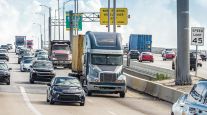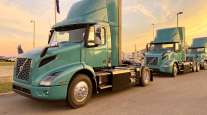Senior Reporter
More Steps Needed to Reach Zero-Emission Future, Executives Say
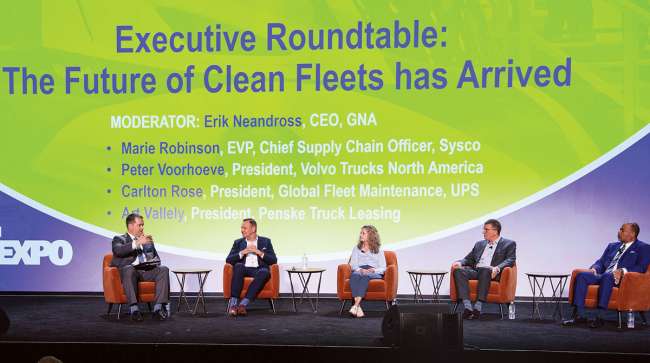
[Stay on top of transportation news: Get TTNews in your inbox.]
LONG BEACH, Calif. — Top executives at some of the largest companies in trucking said many factors must come together before the industry can fully advance toward a zero-emission future.
Even as momentum builds on multiple fronts, they stressed that the expected transition must be practical both from financial and operational standpoints, and must consider the needs of all types of carriers.
“I would like to see the demand and the supply meet, where we have an opportunity to pick what we want,” said Carlton Rose, president of global fleet maintenance for UPS Inc., during a panel discussion at ACT Expo, held May 9-12. “But I applaud the truck makers. They are working hard and bringing this technology forward, and we at UPS are delighted to be a part of it.”
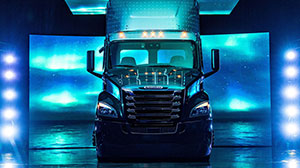
(Daimler)
More From ACT Expo
UPS Inc. ranks No. 1 on the Transport Topics Top 100 list of the largest for-hire carriers in North America.
Art Vallely, president of Penske Truck Leasing, said total cost of ownership for both battery-electric and hydrogen fuel cell trucks must align with fleets’ goals — especially carriers that will turn to his company to sample the technologies. Those companies will need vehicles with much-improved range and the ability to be fast-charged everywhere, a factor that he said could help speed adoption.
“I don’t think the industry — the regulators, collectively everybody — can forget the smaller customers, the medium-sized fleets, the core of our business,” Vallely said. “Take into account the pressures they are feeling. How do we get them from here to there in a way that is economically feasible?”
Penske Logistics ranks No. 14 on the Transport Topics Top 100 list of the largest for-hire carriers in North America and No. 21 on the TT Top 100 list of the largest logistics companies.
Also vital is a secure, stable, efficient and clean electric grid that carriers can depend upon, said Marie Robinson, chief supply chain officer for Sysco Corp. “[A grid] where we don’t have to worry about it when there is a 110-degree heat wave in Texas,” she said. “Working together and making sure that — with our regulatory partners and elected officials — we understand the plans. Everything falls apart if we don’t have that clean, safe electric grid to depend upon.”
Sysco Corp. ranks No. 2 on the Transport Topics Top 100 list of the largest private carriers in North America.
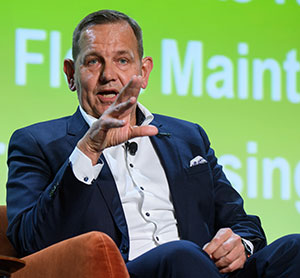
Voorhoeve makes a point. (NHOUSE Photo Services for Gladstein Neandross and Associates)
Robinson urged regulators to create a “smooth, welcoming” on-ramp for EVs in trucking and a “graceful” offramp for the diesel vehicles so that carriers, from a commercial perspective, “are not put in a position where we are having to over-invest on the diesel side, which frankly limits your ability to invest on the electric or alternative side.”
Peter Voorhoeve, president of Volvo Trucks North America, noted that sufficient infrastructure and charging will also prevent half-measures in terms of a ramp-up.
“Otherwise, you are going to stand still halfway, and that doesn’t work,” he said. “We need incentives programs for the long run — then we have more volume, and the whole technology will be more affordable.”
Voorhoeve also lobbied for a thoughtful overall regulatory framework. “One framework that involves all the stakeholders. This is where we want to go,” he said.
Rose also stressed the importance of parts availability, especially amid the current supply chain disruptions that are slowing availability and delivery of components. He advised suppliers to think long-term with their customers.
Want more news? Listen to today's daily briefing above or go here for more info
“We have seen parts go up 300%-350% — it can’t stay there,” he said. “There’s people taking [short-term] advantage of the shortage right now, but we don’t have short-term memories on those people. That’s something to think about.”
Especially since the pace of adoption may soon accelerate.
Erik Neandross, CEO of Gladstein, Neandross & Associates, noted the California Air Resources Board as soon as October may consider a new regulation, the Advanced Clean Fleet rule, that will pull fleets into the world of 100% zero-emission fleet operations. CARB said it is developing the medium- and heavy-duty zero-emission fleet regulation using various timelines with the goal of achieving a zero-emission truck and bus California fleet by 2045, “everywhere feasible and significantly earlier for certain market segments, such as last-mile delivery and drayage applications,” it said.



